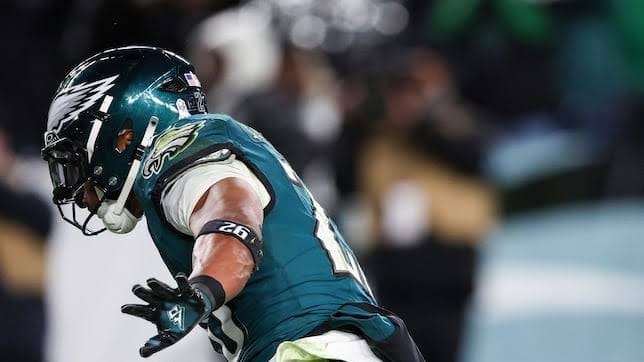For a two-year span, the New York Jets protected the end zone better than nearly every team in football.

From 2022-23, the Jets had the NFL’s third-best red zone defense, allowing a touchdown on just 48.4% of opponent red zone trips. Only the Ravens and Titans fared better.
The 2024 season was a fall from grace. New York ranked just 17th in red zone defense, letting their combatants find paydirt on 58.7% of their trips into the coveted 20-yard range.
Turning this around will be a priority for new Jets head coach Aaron Glenn. Holding up in the red zone was one of the calling cards of Glenn’s Detroit Lions defense.
Detroit let up plenty of yards in 2024 (20th-ranked 342.4 per game), but the Lions’ defense thrived because of their performance in clutch situations. Alongside their top-ranked third-down defense (32.4%), Detroit ranked seventh-best in the red zone (50.9%).
How can Glenn bring the Jets back to red zone glory?
Many of the same cornerstones who anchored the Jets’ 2022-23 defense are still on the roster, including Sauce Gardner, Quinnen Williams, Quincy Williams, Michael Carter II, and Jermaine Johnson. With the addition of Glenn’s expertise, the Jets are equipped for a return to their resilient ways in the red area.
On Sunday, we discussed the Jets’ paths to red zone excellence on offense. Today, let’s discuss some of the ways New York can make the same turnaround on defense.
Improvements at safety
New York’s safeties struggled in coverage throughout the 2024 season, especially in the red zone.
Overall, the Jets’ safeties combined to allow nine touchdowns in coverage, tied for the seventh-most among safety units. They did a good job of preventing long touchdowns, as just one of those nine touchdowns came from more than 20 yards out. However, this also means they allowed eight touchdowns in the red zone.
As a team, the Jets allowed 15 touchdown passes in the red zone, so more than half of them were allowed by a safety.
Chuck Clark (4 touchdowns) was the worst offender. Isaiah Oliver (2), Ashtyn Davis (1), and Jalen Mills (1) were involved in the struggles. Tony Adams did a solid job, yielding only one touchdown on 435 coverage snaps (most among Jets safeties).
Through their additions in free agency and the draft, the Jets have positioned themselves to improve in this area.
Clark is out at free safety and will be replaced by Andre Cisco, a quality cover man who should improve upon Clark’s four touchdowns allowed. Cisco has allowed seven touchdowns over 1,867 career coverage snaps, which would have projected to approximately 1.5 touchdowns over Clark’s sample of 389 coverage snaps in 2024.
New York drafted Alabama captain Malachi Moore in the fourth round, who projects as a solid free safety in the NFL. Moore must work on his physicality in the box and reduce his tendency for busted coverages, but his overall technique and instincts in coverage are fantastic. He allowed zero red zone touchdowns in 2024, his only season as a full-time safety in college.
Make teams go to the air
The Jets’ main issue in the red zone was that they could not stop teams from continuously pounding them in the run game. Once they got near the end zone, opponents would hammer away with one rush attempt after the next, and even if New York stopped the first try or two, they knew the Jets would eventually break.
New York faced the fourth-most red zone rush attempts in the NFL (102), which led to their allowing 22 rushing touchdowns in the red zone, tied for the second-most with the abysmal Carolina Panthers defense. They were one spot behind the Dallas Cowboys, another poor defensive team.
Dallas and Carolina were the two worst defenses of the 2024 season in terms of scoring. It goes to show that getting physically overpowered in the red zone is a hallmark trait of bad defenses.
To curb this issue, the key for New York is dissuading teams from hammering away with consecutive rushing attempts.
The Jets’ pass defense was better than their run defense in 2024, and that will likely be the case again in 2025. The run defense was hardly improved on paper, especially on the interior. Without the necessary reinforcements to strengthen their ability to hold up against red zone rush attempts, the Jets’ focus must be to prevent teams from attempting to run the ball in the first place. Forcing teams to pass in the red zone will give the Jets a much better chance of holding up.
How can they do that? Be aggressive on first down in search of negative plays.
Most of the Jets’ red zone issues occurred after first down. Of the 22 rushing touchdowns they allowed in the red zone, 13 were after first down, tying them with Dallas for the most in the league. They also allowed a 48.8% conversion rate on post-first-down red zone rushing attempts, which ranked fifth-worst.
What the Jets must do is generate negative plays on first down to discourage teams from going back to the run on the later downs. If the Jets can consistently start a series of red zone downs by producing a sack, stuffing a run for a loss or no gain, or drawing a penalty, they can back teams off the line-to-gain and force them to go pass-heavy on second through fourth down.
Pulling this off will require a high-risk, high-reward approach. The Jets need to play aggressively on first down to back teams into obvious passing situations, even if it leaves them susceptible to getting burned. That is just the risk they will have to take to make up for their inability to hold up against persistent rush attempts in the red zone.
Glenn is the perfect coach to enforce this strategy. He established himself as a blitz-heavy coordinator in Detroit; his Lions had the NFL’s third-highest blitz rate in 2024 at 38.4%.
Glenn should maintain a heavy blitz rate on first downs in the red zone. This would increase the Jets’ chances of generating sacks or tackles for loss, helping them avoid situations where teams slowly march their way into the end zone with one short run after another.
The risk of this approach is that the Jets would leave themselves vulnerable in the back end. They would reduce the traffic in the secondary and give the quarterback some enticing man-to-man matchups to attack. They could also become susceptible to pick plays or screens.
It is a risk the Jets can afford to take, though, considering they have the proper pieces in coverage to mitigate that risk. The lengthy cornerback duo of Sauce Gardner and Brandon Stephens is built to thrive in press-man coverage, while Michael Carter II can hold his own in the slot. Azareye’h Thomas gives them a fourth corner who can be trusted in press-man.
With this cornerback unit, the Jets are equipped to blitz heavily in the red zone. They can send extra rushers and trust the corners to survive on their islands.
This plan might sound like a dicey proposition, but here is the reality: This Jets roster is littered with holes that will have to be worked around. It won’t be easy, but it can be done. It will require creativity from the coaching staff and for the stronger parts of the roster to pull heavier weights than usual. On top of that, it will require some gambling, and thus, a little bit of luck.
Look for Glenn and the Jets to live on the edge in the red zone this year.



